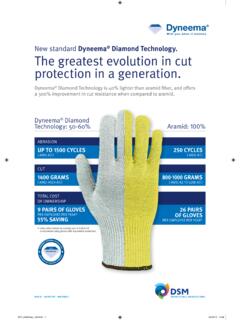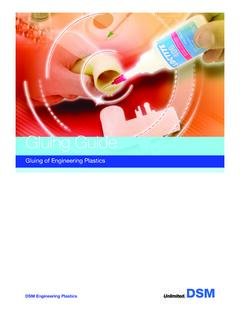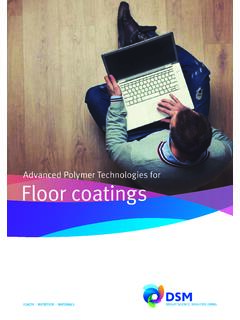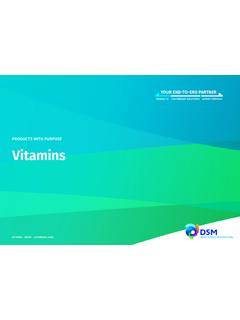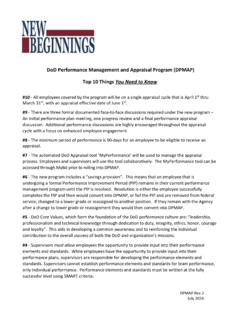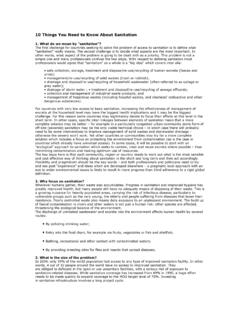Transcription of 10 Things You Need to Know About Premixes - DSM
1 10 Things You Needto know About Premixesby DSM Nutritional ProductsApproximately 80% of the pet food industry uses Premixes in theproduction of their complete and balanced pet food products. Apremix is a blend of micronutrients that are individually addedto pet food in micro amounts. Combining these ingredients ina premix simplifies the weighing process and improves accuracyin mixing and distribution of these micronutrients throughout thefood. But, if you think a premix is just a blend , think on more than 50 years of experience producing micro -nutrients and Premixes for the animal nutrition and health industries, here are the 10 most important Things you need toknow About Premixes :Nutrient form quality Be it a vitamin, mineral, carotenoid, or other nutritionally active compound produced by either chemical synthesis, fermentation, or mined and milled, quality plays no less a role thanany other food or feed ingredient.
2 During production of these nutritional compounds there is a possible qualityrisk based on exposure to chemical solvents, unreacted intermediates, compounds produced by side-reac-tions, and the introduction of other contaminants. This is controlled by use of proper chemistry (not alwaysproducing the highest yield) and a strict incoming and outgoing quality control system. This should be thebasis for selecting nutrient compound producers that are reputable and have brand equity to form potency Much depends on the potency of a nutrient form used in a premix. If the dietaryrequirements are low ( biotin), proper distribution of the nutrient compound throughout the food productis dependent on a nutrient form that has a consistent amount of that nutrient in each particle. Simply dilutingthe nutrient compound with a carrier increases the risk of over or under fortification. Conversely, use of a highpotency nutrient form may be necessary to avoid excessively diluting the other components in the premix ultimately negatively impacting the homogeneity of the form stability Many nutrient compounds react with their environment ( oxygen, moisture)or other compounds in close proximity ( metals, acids) which reduces their potency and/or forms unde-sirable compounds.
3 Building a nutrient form to protect the nutrient compound is essential. Many form tech-nologies can be used to stabilize nutrient compounds by controlling oxidation, minimizing contact with hostilecompounds, or shield the compound from high heat processing. These technologies employ a variety of meth-ods such as molecule appropriate antioxidants plus specialized carrier materials and processes designed toencapsulate small amounts of the nutrient compound in a matrix. Nutrient form physical characteristics producing a quality premix requires an understanding of particledynamics. An example of how mixing different types of particles together can influence premix quality wouldbe to place magnetized heavy metal balls in a bowl with the same size wooden balls. After mixing, the twotypes of balls would not be uniformly mixed together no matter how vigorous or long they were mixed. Particlesize, shape, density, and electrostatic characteristics of each nutrient form play a huge role in how easy it isto create a homogenous mixture and how stable that mixture is through transport and application.
4 To ensurea homogeneous mixture, the closer the particles are in physical characteristics the better the mix. It is alsoimportant to avoid particle characteristics which contribute to electrostatic buildup to prevent separation inthe premix. 1234 Carriers and other adjuncts Since nutrient forms will not be the same in size, shape, or density, carriersand other adjuncts can help bridge the gap. Carriers such as rice hulls and wheat middling provide a largesurface area or pockets for the nutrient forms to adhere. Mineral oil helps the particles stick to the surface ofthe carrier and holds down fine particles that can produce dust. Calcium carbonate is used to increase thebulk density of the premix and improves equipment and procedure There are many types of dry blending equipment. Each type is designed to impart a particular mechanical action depending on the purpose. For micronutrient Premixes ,the focus is on low shear and interlacing particle flow to generate a homogenous mixture in the least amountof time.
5 This not only improves production efficiency, but also promotes nutrient integrity by limiting the wearand tear of the mixing process on the various nutrient product forms. Using the proper mixing equipment andprocedures help to ensure a homogeneous and stable premix. Carryover from one premix batch to the next,is another concern in a premix production facility. Carryover is minimized through line isolation, sequencing,system flushes, and wash down protocols. Premix formulation and use rate Like building a quality finished pet product - formulation is key. For-mulating a vitamin concentrate premix, vitamin and trace mineral premix, or complete blend requires carefulconsideration. Beginning with a target nutrient requirement for the finished pet food product, experiencedformulators understand how all these points affect premix quality. They must also account for the intendeduse and required shelf life of the pet food product.
6 The intended use drives the nutrient form and carrier selection, nutrient overages, and use rate unless dictated. Quality program In any production operation, a strong quality program is needed to ensure ongoingsuccess. During routine premix operations it is necessary to have proper weighment controls, inventory mon-itoring systems, and control sample checks, to identify non-conformities before the premix is approved forshipping. Monitoring programs to routinely measure homogeneity, formulation accuracy, and carryover arenecessary and require careful consideration and planning. This encompasses choosing the nutrients to testand the frequency of testing, ensuring collection of representative samples, determining appropriate analyt-ical methods to ensure accurate measurement of the active compounds, and understanding all the variancesassociated with each element of the of Premixes Even after a premix is produced, premix quality can be affected by handling andstorage conditions.
7 Transport and storage under humid or high temperature conditions can contribute to nutrient degradation. Application of the premix in the pet food production site can further stress premix com-ponents. The physical conveyance of a premix through the pet food production process (via screw conveyeror pneumatic transfer) can negatively impact nutrient stability or premix homogeneity depending on the food process and point of addition There are several different processes that can be used to add apremix to pet food products. The premix may be mixed with other dry ingredients prior to extrusion throughhigh pressure, high temperature, and high sheer conditions before baking/drying. Or the premix may be mixedwith semi-frozen meats, and then heated, canned, and retorted under high moisture and heat should be given to how effectively the premix particles are distributed throughout the pet foodformulation and to the environment at the point of addition.
8 Some processes, such as adding the premix toa liquid slurry prior to mixing with macro ingredients, could be thought to enhance distribution of the premixcomponents. However, the slurry environment (possibly a very high pH) may act to accelerate degradation ofsome The alternative would be to add the premix separately into the macro ingredient blend wherethe environment is neutral and more conducive to stability. Care and consideration should be given to howeach step of the process influences the quality of the more information contact your DSM Nutritional Products representativeor e-mail NUTRITION MATERIALS
